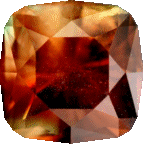| |
Sunstone
|
Sunstone receives its name from its semblance to the sun. It is a feldspar with many small specks of pyrite or copper resulting in a golden shimmering effect called aventurescence.
The modern sunstone does not appear in the early lapidaries as it was only discovered in the 1800s, and has remained rarely used in jewelry in spite of its beauty. Because of this there is not much historical folklore attached to the material outside of a single indigenous north American story that claims the color is due to a brave warrior’s blood falling on the stone as he was slain, and that the glow is his spirit. The stone was believed to banish evil, make the wearer brave, and allow them to strike spirits. This may be a very modern story as the earliest written account of the story seems to date from the 1940s. There is evidence that the stone was worked by pre-Columbian peoples, but the cultural significance of it is lost to time.
There is some confusion by modern readers regarding the identity of similarly named stones in early lapidaries and historical accounts. Many cite the solis gemma as evidence of the sunstone being known to the old world philosophers. Though the term translates into “jewel of the sun”, the name was applied to the higher grades of adularia, a blue variety of true moonstone. This was because the optical phenomenon seen in the stone, called adularescence, resembled the sun in a blue sky.
The other often miscited account refers to the Norse sunstones. These were special clear stones that were used for navigation by identifying the suns’ location even on cloudy days. Though thought of as purely folkloric for many years, the presence of Iceland spar among the navigation equipment of a medieval ship wreak has caused archeologists to reexamine this myth. Whether fact or fiction, it can be said with certainty that the Norse sunstone was not the modern sunstone.
I cannot help but wonder if the “brave warrior” of the indigenous north east may have been a metaphor for the sun itself. Several cultures have linked the sun to slain god myths, and it would help explain some of the folkloric properties of the stone if it was believed to possess a piece of a solar spirit. People became braver by day than night, and the sunlight was often believed to dispel illusions and destroy evil spirits in folkloric practice. It is not without irony that I suspect that had the early lapidaries encountered the sunstone, they very well might have bestowed upon it similar virtues due to the doctrines of sympathic magic.
|
Colors
|
Orange, red, brown, with aventuresence.
|
Locations
|
Russia, Norway, Canada & the United States
|
Compisition
|
NaAlSi3O8
or
CaAl2Si2O8
|
Hardness
|
6
|
|

|

|

|
|
|
|
|
|